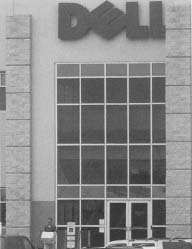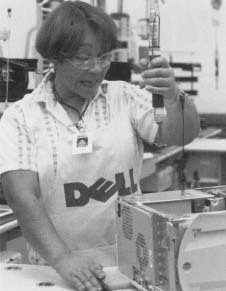Dell Computer
Corporation
2214 West Braker Lane, Suite D
Austin, TX 78758
(512) 338-4400
www.dell.com

In the history of computers and electronics, several well-known companies got their start in their founders' garages. Dell Computer Corporation (DCC) may be the only leading computer company in the world that began in a college dorm room. Michael Dell was an eighteen-year-old freshman at the University of Texas when he decided to put more time into selling computers than attending classes. From there, Dell went on to build one of the fastest-growing companies ever, changing how computers are sold, and making himself a billionaire.
Big Doings in Room 2713
When Michael Dell entered the University of Texas at Austin in 1983, he was already somewhat of a computer nerd. A biology major intending to go into medicine, Dell had bought his first computer, an Apple II, when he was fifteen years old (see Apple Computer, Inc. entry). In Direct from Dell, the story of his company, Dell describes how he picked up the computer with his parents, "I jumped out of the car, carried the precious cargo to my room, and with great relish, promptly took my computer apart." Dell learned how to improve a computer's performance by adding new parts, and by the time he reached college, he already had a small business selling upgraded machines.
Dell continued his business at the University of Texas, as local business owners and professionals heard about his work and visited his dorm, Room 2713 in Dobie Hall. "I'd put in some memory or a disk drive," Dell told Fortune in 1999, "they'd pay me, and I'd send them on their way." He also advertised in local papers, promising computers at prices lower than retail stores. In January 1984, Dell formed a company called PC's Limited. Sales reached $30,000 a month and kept growing. Before the end of the school year, Dell officially incorporated his business as Dell Computer Corporation.
From upgrading existing IBM machines, DCC began building and selling "clones"—computers that were similar to IBM PCs. From the beginning, Dell decided to cut out the middleman—retail stores—and sell directly to consumers. He shipped computers to them through the mail. By building a computer only after a customer ordered it, Dell did not have to spend money buying and storing large quantities of parts. When prices for parts fell, the company could pass on savings to its customers much more quickly than competitors could. Dell also saved money by not hiring the sales and marketing people most companies used. By the end of 1985, Dell was selling its clones for about 40 percent less than an IBM machine. The company moved into a larger building in Austin, employing about one hundred people.
Dell at a Glance
- Employees: 34,600
- CEO: Michael Dell
- Subsidiaries: DCC Executive Security Inc.; SFD/SPV LP.
- Major Competitors: International Business Machines (IBM); Hewlett-Packard Company; Gateway, Inc.; Sun Microsystems, Inc.; Apple Computer, Inc.; Hitachi, Ltd.
- Notable Products: PowerEdge servers; PowerApp servers; PowerVault storage products; Precision workstation; Opti-Plex desktop computers; Dimension desktop computers; Latitude notebook computers; Inspiron notebook computers; SmartStep desktop and notebook computers
Becoming One of the "Big Boys"
By the end of 1986, Dell's sales reached $60 million, and the company won praise for its newest computer, the fastest IBM clone of the time. The next year, Dell became the first U.S. computer company to offer next-day, on-site repair services, using technicians provided by another company. Customers could also call in for technical help; Dell learned that most problems could be solved in a few minutes.
This constant interaction with customers helped Dell learn what computer users wanted, so the company could offer products that served their needs. The calls also helped Dell identify production problems. If one model received many complaints, Dell engineers modified the design. The company' slogan became, "When you talk, we listen."
Timeline
- 1983:
- Michael Dell begins selling computers while attending the University of Texas.
- 1984:
- Dell officially forms Dell Computer Corporation and leaves school to focus on his business; Dell becomes one of the first companies to make clones of IBM personal computers.
- 1986:
- Dell introduces the world's fastest personal computer (at that time).
- 1988:
- The sale of 3.5 million shares of Dell stock raises $30 million.
- 1990:
- Dell opens its first overseas manufacturing plant, in Limerick, Ireland.
- 1992:
- Annual sales at Dell reach $2 billion.
- 1994:
- Dell stops selling computers at retail stores to focus on direct sales.
- 1996:
- Dell begins making servers and soon captures a large share of that market.
- 2000:
- Slashing prices, Dell sets off a PC price war that boosts sales.
The attention to customer service and lower prices helped Dell grow. By the end of 1989, the company's sales were $258 million, with profits of more than $14 million. Michael Dell and his "direct business model" were winning national attention, and Inc. named Dell its "Entrepreneur of the Year." The next year, however, the company hit a rough spot. It spent heavily on research and development and made a wrong choice about which microprocessor, or chip, to use in its computers. Sales increased, but profits fell. "We made some mistakes," Dell told Nation's Business in April 1991, "but we also had the strength to work our way out."
By 1991, Dell was firmly established internationally, with a manufacturing plant in Ireland. At home, the company focused its sales on businesses, schools, and government agencies, selling about half of its computers to those markets. For home use, Dell targeted more experienced computer users, people who knew exactly what they wanted and didn't need help from a store clerk. The company controlled just over 1 percent of the U.S. computer market, but it was poised to grow even more, and its profits remained healthy while other computer companies struggled.
In 1986, Dell and his top executives said they wanted annual sales to reach $1 billion by 1992. They were off the mark: DCC sales were $2 billion that year. Dell, however, faced another difficult stretch in 1993. Problems with the design of some of its notebook computers forced the company to halt development. A financial analyst accused the company of using questionable accounting tactics. Dell's stock price fell dramatically.
The Road to Number One
Dell decided he needed more expertise in running a large corporation, so he hired talented executives from other computer firms. He also changed the company's focus. Growth was no longer the only goal. It had to be balanced with profits and liquidity, or cash on hand. In 1994, the company introduced a new notebook computer with a longer battery life, which became a hit with consumers. DCC also focused more on selling higher-priced machines to businesses, which generated more profit.
Going Retail
In 1990, Dell Computer Corporation made its first agreement to sell computers through retail stores. It partnered with Soft Warehouse (now CompUSA) and sold its machines at warehouse stores, then later moved into other large retail outlets. At first, sales were fair, but over time Dell found it could not compete with Compaq, which was better known at the time, or Packard Bell, which offered lower prices. Dell ended its experiment in retail sales in 1994. Chief financial officer (CFO) Tom Meredith told Fortune the next year, "We were losing our shirts."
Dell's ability to custom-make machines appealed to its business clients. Dell even added custom software for certain

Throughout the rest of the 1990s, Dell's sales grew, and its rising stock made Michael Dell one of the richest people in the United States. The company's business philosophy became what Dell called "virtual integration." In other industries, a key to growth is vertical integration—controlling all aspects of a business, from making the basic parts, to assembly, to sales and repairs. Dell preferred to work with outside companies to achieve almost the same result at a lower cost. DCC turned to outside suppliers for its parts, working closely with their engineers. "They assign their engineers to our design team," Dell explained to the Harvard Business Review in 1998, "and we start to treat them as if they were part of the company."
Dell also continued to pay close attention to its customers' needs. For its largest corporate customers, the company built special Web sites called "Premier Pages." Workers at these corporations had direct access to information about the specific computers Dell built for their company. Dell also began holding "Platinum Councils," meetings with managers from these large clients. Comments and concerns from these council members helped Dell shape its new products.
By 2000, Dell's annual sales reached more than $25 billion, as computer sales boomed during the late 1990s. Dell passed Compaq in 1999 to become the world's largest seller of desktop PCs; notebook sales also remained strong. The market, however, began to shrink as the new century began. Dell had already started looking for new ways to boost sales. It began making servers, the more powerful computers used to connect PCs into networks. In this market, it faced tough competition from well-known companies, such as Hewlett-Packard (see entry), Sun Microsystems, and Compaq. Still, with much lower prices and a good product, Dell proved successful. It then turned to storage systems used to hold the large amounts of data used on the Internet. Some business experts and competitors questioned Dell's ability to succeed in these new areas. "Just as people doubted us [before]," Dell told Fortune in October 2000, "they doubt us now. Bring them on. We're coming right at them."
Cutting Prices with the "Dude"
For years, Dell tried to focus on the commercial computer market, where it could make more profit on each computer sold. The slowing of computer sales in 2000 led the company to try a new tactic. For the first time, it began slashing prices on computers geared to home users. Dell's move began a price war, as leading competitors cut their prices to try to keep their share of the market. Dell's cheapest machine, the SmartStep desktop, cost just $599.
Along with the price cut, Dell began its first major television campaign. The ads showed a young man, Steven, telling his friend's parents why they should buy a Dell. After his convincing sales pitch, Steven assured his friends, "Dude, you're getting a Dell." Steven became known as the "Dell Dude," and the commercials were noticed around the United States. Steven's pleasant goofiness and sense of humor appealed to people of all ages, and made the actor who played him, college student Ben Curtis, something of a star. He began receiving fan mail and one fan built a Web site dedicated to him.
For Dell, the commercials doubled their name recognition with the general public. The ads, along with the lower prices, also helped Dell increase its share of the home PC market in the United States, while its major competitors lost market share.
Looking Ahead
The overall economic slowdown of 2001, along with decreased PC sales, affected Dell and other computer makers. Dell's sales reached almost $32 billion in 2000, then remained flat the following year. The company had its first major layoff ever in February 2001, letting go seventeen hundred employees. Still, the company had many strengths. Although profits fell in the fiscal (financial) year ending in February 2002, they remained over $1 billion. The company continued to win a larger share of the server and storage markets, and it seemed poised for growth in Asia, where it has two manufacturing sites (in Malaysia and China). Worldwide, Dell was the leading PC maker.
Comment about this article, ask questions, or add new information about this topic: